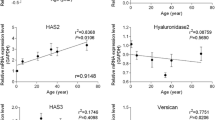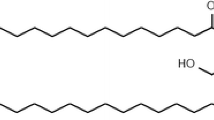Abstract
It has been reported that hyaluronan has different physiological functions as suggested by variation in molecular weight. In addition, it has also been reported that CD44, the major hyaluronan receptor, was demonstrated to induce keratinocyte differentiation and lipid synthesis of cholesterol. We focus attention on the hyaluronan tetrasaccharides (HA4) which is the smallest unit of hyaluronan. We previously reported that HA4 induced keratinocyte differentiation and that CD44 may be involved. For the purpose of clarifying the influence of HA4 on ceramide synthesis, we evaluated both of these factors in keratinocytes in vitro and in vivo. The mRNA expression of ceramide synthesis-associated enzymes and intracellular ceramide content were evaluated after HA4 treatment in normal human epidermal keratinocytes. In addition, the ceramide increasing effect of HA4 on skin in UVA-irradiated hairless mice was assessed by water content of stratum corneum (SC) and transepidermal water loss (TEWL) methods. The mRNA expression of ceramide synthesis-associated enzymes and intracellular ceramide content after HA4 treatment were increased compared with the control. Furthermore, HA4 treatment increased water content of SC and decreased TEWL. These findings suggest that HA4 affected ceramide synthesis and is involved in the improvement of UV-induced skin damage.





Similar content being viewed by others
References
Akimoto K, Yoshikawa N, Higaki Y, Kawashima M, Imokawa G (1993) Quantitative analysis of stratum corneum lipids in xerosis and asteatotic eczema. J Dermatol (Tokyo) 20(1):1–6
Aruffo A, Stamenkovic I, Melnick M, Underhill CB, Seed B (1990) CD44 is the principal cell surface receptor for hyaluronate. Cell 61(7):1303–1313
Bligh EG, Dyer WJ (1959) A lipid method of total lipid extraction and purification. Can J Biochem Physiol 37(8):911–917
Bourguignon LYW, Ramez M, Gilad E, Singleton PA, Man M, Crumrine DA, Elias PM, Feingold KR (2006) Hyaluronan-CD44 interaction stimulates keratinocyte differentiation, lamellar body formation/secretion, and permeability barrier homeostasis. J Invest Dermatol 126:1356–1365
Farrell AM, Uchida Y, Nagiec MN, Harris IR, Dickson RC, Elias PM, Holleran WM (1998) UVB irradiation up-regulates serine palmitoyltransferase in cultures human keratinocytes. J Lipid Res 39:2031–2038
Grubauer G, Feingold KR, Harris RM, Elias PM (1989) Lipid content and lipid type as determinants of the epidermal permeability barrier. J Lipid Res 30:89–96
Holleran WM, Feingold KR, Man MQ, Gao WN, Lee JM, Elias PM (1991) Regulation of epidermal sphingolipid synthesis by permeability barrier function. J Lipid Res 32:1151–1158
Holleran WM, Ginns EI, Menon GK, Grundmann JU, Fartasch M, McKinney CE, Elias PM, Sidransky E (1994) Consequences of beta-glucocerebrosidase deficiency in epidermis. Ultrastructure and permeability barrier alterations in Gaucher disease. J Clin Invest 93(4):1756–1764
Holleran WM, Takagi Y, Menon GK, Legler G, Feingold KR, Elias PM (1993) Processing of epidermal glucosylceramides is required for optimal mammalian cutaneous permeability barrier function. J Clin Invest 91(4):1656–1664
Imokawa G, Abe A, Jin K, Higaki Y, Kawashima M, Hidano A (1991) Decreased level of ceramides in stratum corneum of atopic dermatitis: an etiologic factor in atopic dry skin? J Invest Dermatol 96:523–526
Imokawa G, Akasaki S, Hattori M, Yoshizuka N (1986) Selective recovery of deranged water-holding properties by stratum corneum lipids. J Invest Dermatol 87:758–761
Imokawa G, Akasaki S, Minematsu Y, Kawai M (1989) Importance of intercellular lipids in water-retention properties of the stratum corneum: induction and recovery study of surfactant dry skin. Arch Dermatol Res 281(1):45–51
Imokawa G, Hattori M (1985) A possible function of structural lipids in the water-holding properties of the stratum corneum. J Invest Dermatol 84:282–284
Jin K, Higaki Y, Takagi Y, Higuchi K, Yada Y, Kawashima M, Imokawa G (1994) Analysis of beta-glucocerebrosidase and ceramidase activity in atopic and aged dry skin. Acta Derm-Venereol 74(5):337–340
Kage M, Tokudome Y, Hashimoto F (2013) Permeation of hyaluronan tetrasaccharides through hairless mouse skin: an in vitro and in vivo study. Arch Dermatol Res 305(1):69–77
Kage M, Tokudome Y, Matsunaga Y, Hariya T, Hashimoto F (2013) Expression of hyaluronan synthase and collagen type I mRNA by hyaluronan tetrasaccharides in normal human dermal fibroblasts. J Jpn Cosmet Sci Soc 37(1):1–5
Kage M, Tokudome Y, Matsunaga Y, Hariya T, Hashimoto F (2014) Effect of hyaluronan tetrasaccharides on epidermal differentiation in normal human epidermal keratinocytes. Int J Cosmet Sci 36(1):109–115
Lampe MA, Burlingame AL, Whitney J, Williams ML, Brown BE, Roitman E, Elias PM (1983) Human stratum corneum lipids: characterization and regional variations. J Lipid Res 24:120–130
Mizutani Y, Mitsutake S, Tsuji K, Kihara A, Igarashi Y (2009) Ceramide biosynthesis in keratinocyte and its role in skin function. Biochimie 91:784–790
Uchida Y, Hara M, Nishino H, Sidransky E, Inoue S, Otsuka F, Suzuki A, Elias PM, Holleran WM, Hamanaka S (2000) Epidermal sphingomyelins are precursors for selected stratum corneum ceramides. J Lipid Res 41:2071–2082
Uchida Y, Naido AD, Collins V, Elias PM, Holleran WM (2003) De novo ceramide synthesis participates in the ultraviolet B irradiation-induced apoptosis in undifferentiated cultured human keratinocytes. J Invest Dermatol 120:662–669
Wefers H, Mclnik BC, Flur M, Bluhm C, Lehmann P, Plewig G (1991) Influence of UV irradiation on the composition of human stratum corneum lipids. J Invest Dermatol 96:959–962
Weigel PH, Hascall VC, Tammi M (1997) Hyaluronan synthases. J Biol Chem 272(22):13997–14000
Xu H, Ito T, Tawada A, Maeda H, Yamanokuchi H, Isahara K, Yoshida K, Uchiyama Y, Asari A (2002) Effect of hyaluronan oligosaccharides on the expression of heat shock protein 72. J Biol Chem 277:17308–17314
Acknowledgments
The authors gratefully acknowledge the technical assistance of Ms. Asami Nakai.
Author information
Authors and Affiliations
Corresponding author
Rights and permissions
About this article
Cite this article
Kage, M., Tokudome, Y. Hyaluronan tetrasaccharides stimulate ceramide production through upregulated mRNA expression of ceramide synthesis-associated enzymes. Arch Dermatol Res 308, 95–101 (2016). https://doi.org/10.1007/s00403-015-1615-6
Received:
Revised:
Accepted:
Published:
Issue Date:
DOI: https://doi.org/10.1007/s00403-015-1615-6




